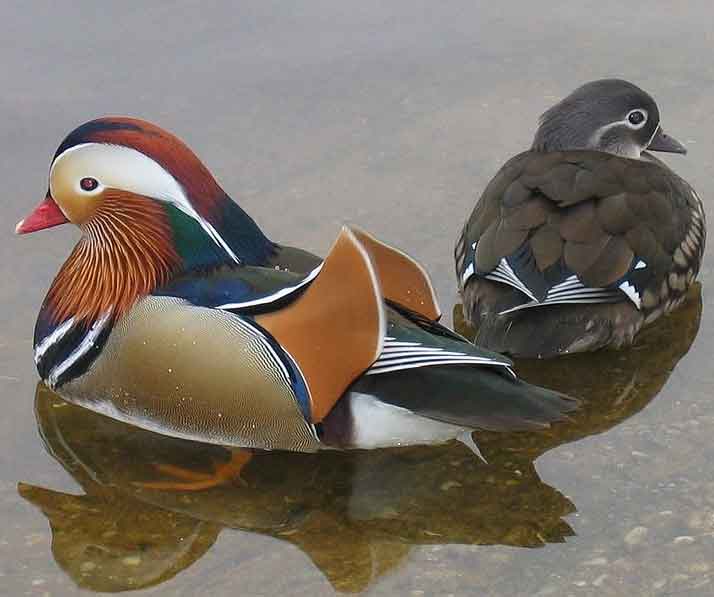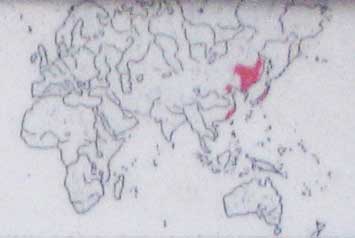
Aix galericulata (*)
Superregnum: Eukaryota
Cladus: Unikonta
Cladus: Opisthokonta
Cladus: Holozoa
Regnum: Animalia
Subregnum: Eumetazoa
Cladus: Bilateria
Cladus: Nephrozoa
Superphylum: Deuterostomia
Phylum: Chordata
Subphylum: Vertebrata
Infraphylum: Gnathostomata
Megaclassis: Osteichthyes
Cladus: Sarcopterygii
Cladus: Rhipidistia
Cladus: Tetrapodomorpha
Cladus: Eotetrapodiformes
Cladus: Elpistostegalia
Superclassis: Tetrapoda
Cladus: Reptiliomorpha
Cladus: Amniota
Classis: Reptilia
Cladus: Eureptilia
Cladus: Romeriida
Subclassis: Diapsida
Cladus: Sauria
Infraclassis: Archosauromorpha
Cladus: Crurotarsi
Divisio: Archosauria
Cladus: Avemetatarsalia
Cladus: Ornithodira
Subtaxon: Dinosauromorpha
Cladus: Dinosauriformes
Cladus: Dracohors
Cladus: Dinosauria
Ordo: Saurischia
Cladus: Eusaurischia
Cladus: Theropoda
Cladus: Neotheropoda
Cladus: Averostra
Cladus: Tetanurae
Cladus: Avetheropoda
Cladus: Coelurosauria
Cladus: Tyrannoraptora
Cladus: Maniraptoromorpha
Cladus: Maniraptoriformes
Cladus: Maniraptora
Cladus: Pennaraptora
Cladus: Paraves
Cladus: Eumaniraptora
Cladus: Avialae
Infraclassis: Aves
Cladus: Euavialae
Cladus: Avebrevicauda
Cladus: Pygostylia
Cladus: Ornithothoraces
Cladus: Euornithes
Cladus: Ornithuromorpha
Cladus: Ornithurae
Cladus: Carinatae
Parvclassis: Neornithes
Cohors: Neognathae
Cladus: Pangalloanserae
Cladus: Galloanseres
Ordo: Anseriformes
Familia: Anatidae
Subfamilia: Anatinae
Genus: Aix
Species: Aix galericulata
Name
Aix galericulata (Linnaeus, 1758)
Synonyms
Anas galericulata (protonym)

References
Linnaeus, C. 1758. Systema Naturae per regna tria naturæ, secundum classes, ordines, genera, species, cum characteribus, differentiis, synonymis, locis, Tomus I. Editio decima, reformata. Holmiæ: impensis direct. Laurentii Salvii. i–ii, 1–824 pp DOI: 10.5962/bhl.title.542: 128. Reference page.
Vernacular names
العربية: بط الماندرين
беларуская: Мандарынка
български: Мандаринка
বাংলা: মান্দারিন হাঁস
brezhoneg: Houad mandarin
català: Ànec mandarí
čeština: Kachnička mandarínská
Cymraeg: Hwyaden gribog
dansk: Mandarinand
Deutsch: Mandarinente
English: Mandarin Duck
Esperanto: Mandarena anaso
español: Pato mandarín
eesti: Mandariinpart
euskara: Mandarin ahate
suomi: Mandariinisorsa
føroyskt: Seglont
français: Canard mandarin
Gaeilge: Lacha Mhandrach
galego: Pato mandarín
עברית: מנדרין סיני
hrvatski: Mandarinka
magyar: Mandarinréce
Bahasa Indonesia: Bebek Mandarin
íslenska: Mandarínönd
italiano: Anatra mandarina
日本語: オシドリ
한국어: 원앙
Lëtzebuergesch: Mandarinint
lietuvių: Mandarininė antis
latviešu: Mandarīnpīle
монгол: Мандир уранхажин
Bahasa Melayu: Itik Mandarin
Nederlands: Mandarijneend
norsk nynorsk: Mandarinand
norsk: Mandarinand
Diné bizaad: Náátsʼózídę́ę́ʼ naalʼeełí
polski: mandarynka
پنجابی: مینڈارن بطخ
português: Pato-mandarim
rumantsch: Anda mandarina
русский: Мандаринка
slovenčina: Kačička mandarínska
slovenščina: Mandarinka
svenska: Mandarinand
ไทย: เป็ดแมนดาริน
Türkçe: Mandarin ördeği
українська: Мандаринка
Tiếng Việt: Uyên ương
中文: 鸳鸯
Superregnum: Eukaryota
Cladus: Unikonta
Cladus: Opisthokonta
Cladus: Holozoa
Regnum: Animalia
Subregnum: Eumetazoa
Cladus: Bilateria
Cladus: Nephrozoa
Superphylum: Deuterostomia
Phylum: Chordata
Subphylum: Vertebrata
Infraphylum: Gnathostomata
Megaclassis: Osteichthyes
Cladus: Sarcopterygii
Cladus: Rhipidistia
Cladus: Tetrapodomorpha
Cladus: Eotetrapodiformes
Cladus: Elpistostegalia
Superclassis: Tetrapoda
Cladus: Reptiliomorpha
Cladus: Amniota
Classis: Reptilia
Cladus: Eureptilia
Cladus: Romeriida
Subclassis: Diapsida
Cladus: Sauria
Infraclassis: Archosauromorpha
Cladus: Crurotarsi
Divisio: Archosauria
Cladus: Avemetatarsalia
Cladus: Ornithodira
Subtaxon: Dinosauromorpha
Cladus: Dinosauriformes
Cladus: Dracohors
Cladus: Dinosauria
Ordo: Saurischia
Cladus: Eusaurischia
Cladus: Theropoda
Cladus: Neotheropoda
Cladus: Averostra
Cladus: Tetanurae
Cladus: Avetheropoda
Cladus: Coelurosauria
Cladus: Tyrannoraptora
Cladus: Maniraptoromorpha
Cladus: Maniraptoriformes
Cladus: Maniraptora
Cladus: Pennaraptora
Cladus: Paraves
Cladus: Eumaniraptora
Cladus: Avialae
Infraclassis: Aves
Cladus: Euavialae
Cladus: Avebrevicauda
Cladus: Pygostylia
Cladus: Ornithothoraces
Cladus: Euornithes
Cladus: Ornithuromorpha
Cladus: Ornithurae
Cladus: Carinatae
Parvclassis: Neornithes
Cohors: Neognathae
Cladus: Pangalloanserae
Cladus: Galloanseres
Ordo: Anseriformes
Familia: Anatidae
Subfamilia: Anatinae
Genus: Aix
Species: Aix galericulata
Name
Aix galericulata (Linnaeus, 1758)
Synonyms
Anas galericulata (protonym)
The mandarin duck (Aix galericulata) is a perching duck species native to the East Palearctic. It is medium-sized, at 41–49 cm (16–19 in) long with a 65–75 cm (26–30 in) wingspan. It is closely related to the North American wood duck, the only other member of the genus Aix. 'Aix' is an Ancient Greek word which was used by Aristotle to refer to an unknown diving bird, and 'galericulata' is the Latin for a wig, derived from galerum, a cap or bonnet.[2]
Description
The adult male has a red bill, large white crescent above the eye and reddish face and "whiskers". The male's breast is purple with two vertical white bars, and the flanks ruddy, and he has two orange "sails" at the back (large feathers that stick up like boat sails). The female is similar to the female wood duck, with a white eye-ring and stripe running back from the eye, but is paler below, has a small white flank stripe, and a pale tip to its bill.[3]
Both the males and females have crests, but the purple crest is more pronounced on the male.
Like many other species of ducks, the male undergoes a moult after the mating season into eclipse plumage. When in eclipse plumage, the male looks similar to the female, but can be told apart by its bright yellow-orange or red beak, lack of any crest, and a less-pronounced eye-stripe.
Mandarin ducklings are almost identical in appearance to wood ducklings, and very similar to mallard ducklings. The ducklings can be distinguished from mallard ducklings because the eye-stripe of mandarin ducklings (and wood ducklings) stops at the eye, while in mallard ducklings it reaches all the way to the bill.
Mutations
Various mutations of the mandarin duck are found in captivity. The most common is the white mandarin duck. Although the origin of this mutation is unknown, the constant pairing of related birds and selective breeding is presumed to have led to recessive gene combinations, leading in turn to genetic conditions including leucism.
Distribution and habitat
The species was once widespread in East Asia, but large-scale exports and the destruction of its forest habitat have reduced populations in eastern Russia and in China to below 1,000 pairs in each country; Japan, however, is thought to still hold some 5,000 pairs. The Asian populations are migratory, overwintering in lowland eastern China and southern Japan.[4]
Specimens frequently escape from collections, and in the 20th century, a large, feral population was established in Great Britain; more recently, small numbers have bred in Ireland, concentrated in the parks of Dublin. Now, about 7,000 are in Britain with other populations on the European continent, the largest of which is in the region of Berlin.[5] Isolated populations exist in the United States. The town of Black Mountain, North Carolina, has a limited population,[6] and a free-flying feral population of several hundred mandarins exist in Sonoma County, California. This population is the result of several ducks escaping from captivity, then reproducing in the wild.[3] In 2018, a single bird, dubbed Mandarin Patinkin, was seen in New York City's Central Park.[7]
The habitats it prefers in its breeding range are the dense, shrubby forested edges of rivers and lakes. It mostly occurs in low-lying areas, but it may breed in valleys at altitudes of up to 1,500 m (4,900 ft). In winter, it additionally occurs in marshes, flooded fields, and open rivers. While it prefers fresh water, it may also be seen wintering in coastal lagoons and estuaries. In its introduced European range, it lives in more open habitat than in its native range, around the edges lakes, water meadows, and cultivated areas with woods nearby.[4]
Behaviour
Compared to other ducks, mandarins are shy birds, preferring to seek cover under trees such as overhanging willows, and form smaller flocks,[8] but may become bolder as a result of becoming tame from frequent interaction with humans.
Breeding
A mother with ducklings in Richmond Park, London, England
In the wild, mandarin ducks breed in densely wooded areas near shallow lakes, marshes or ponds. They nest in cavities in trees close to water and during the spring. A single clutch of nine to twelve eggs is laid in April or May. Although the male may defend the brooding female and his eggs during incubation, he himself does not incubate the eggs and leaves before they hatch. Shortly after the ducklings hatch, their mother flies to the ground and coaxes the ducklings to leap from the nest. After all of the ducklings are out of the tree, they will follow their mother to a nearby body of water.[4]
Food and feeding
Male flying in Dublin, Ireland
Mandarins feed by dabbling or walking on land. They mainly eat plants and seeds, especially beech mast. The species will also add snails, insects and small fish to its diet.[9] The diet of mandarin ducks changes seasonally; in the fall and winter, they mostly eat acorns and grains. In the spring, they mostly eat insects, snails, fish and aquatic plants. In the summer, they eat dew worms, small fish, frogs, mollusks, and small snakes.[10] They feed mainly near dawn or dusk, perching in trees or on the ground during the day.[4]
Threats
Predation of the mandarin duck varies between different parts of its range. Mink, raccoon dogs, otters, polecats, Eurasian eagle-owls, and grass snakes are all predators of the mandarin duck.[10] The greatest threat to the mandarin duck is habitat loss due to loggers. Hunters are also a threat to the mandarin duck, because often they are unable to recognize the mandarin in flight and as a result, many are shot by accident. Mandarin ducks are not hunted for food, but are still poached because their extreme beauty is prized.[10]
In culture
Chinese culture
A Yuan Dynasty porcelain teapot representing a mandarin duck pair
Porcelain winepot in the form of a mandarin duck, decorated in overglaze enamels, Qing dynasty, circa 1760
The Chinese refer to Mandarin ducks as yuanyang (simplified Chinese: 鸳鸯; traditional Chinese: 鴛鴦; pinyin: yuānyāng), where 'yuan' (鴛) and 'yang' (鴦) respectively stand for male and female mandarin ducks. In traditional Chinese culture, mandarin ducks are believed to be lifelong couples, unlike other species of ducks. Hence they are regarded as a symbol of conjugal affection and fidelity, and are frequently featured in Chinese art.
A Chinese proverb for loving couples uses the mandarin duck as a metaphor: "Two mandarin ducks playing in water" (simplified Chinese: 鸳鸯戏水; traditional Chinese: 鴛鴦戲水; pinyin: yuānyāng xì shuǐ). A mandarin duck symbol is also used in Chinese weddings because in traditional Chinese lore, they symbolize wedded bliss and fidelity. Because the male and female plumages of the mandarin duck are so unalike, 'yuan-yang' is frequently used colloquially in Cantonese to mean an "odd couple" or "unlikely pair" – a mixture of two different types of same category. For example, the drink yuanyang and yuan-yang fried rice. Mandarin ducks featured on the flag of Weihaiwei during British rule.
Korean culture
See also: Wedding ducks
For Koreans, mandarin ducks represent peace, fidelity, and plentiful offspring. Similar to the Chinese, they believe that these ducks mate for life. For these reasons, pairs of wooden-carved mandarin ducks called wedding ducks are often given as wedding gifts and play a significant role in Korean marriage.[11]
Japanese culture
Similarly, in Japanese the ducks are called oshidori (おしどり/オシドリ/鴛鴦) and are used in the phrase oshidori fūfu (おしどり夫婦, "a couple of lovebirds/happily married couple").
References
BirdLife International (2018). "Aix galericulata". IUCN Red List of Threatened Species. 2018: e.T22680107A131911544. doi:10.2305/IUCN.UK.2018-2.RLTS.T22680107A131911544.en. Retrieved 19 November 2021.
Jobling, James A (2010). The Helm Dictionary of Scientific Bird Names. London: Christopher Helm. pp. 37, 169. ISBN 978-1-4081-2501-4.
Shurtleff, Lawton; Savage, Christopher (1996). The Wood Duck and the Mandarin: The Northern Wood Ducks. University of California Press. ISBN 0-520-20812-9.
Madge, Steve; Burn, Hilary (1987). Wildfowl: An identification guide to the ducks, geese and swans of the world. London: Christopher Helm. pp. 188–189. ISBN 0-7470-2201-1.
Blankennagel, Jens (11 January 2008). "Kunterbunte Einwanderer". Berliner Zeitung (in German). Retrieved 3 February 2012.
"Let's Talk About Birds: Mandarin Ducks". post-gazette.com. 8 February 2012. Archived from the original on 13 June 2015.
"Rare Mandarin Duck Makes A Splash in Central Park". CBS New York. 31 October 2018. Retrieved 3 November 2018.
"Mandarin duck | The Wildlife Trusts". www.wildlifetrusts.org. Retrieved 14 January 2021.
"Mandarin Duck Fact Sheet". Lincoln Park Zoo.
"Mandarin Duck". Honolulu Zoo. Archived from the original on 31 May 2012. Retrieved 5 February 2012.
Chira, Susan (5 October 1986). "The Happy Couple: Korean Wedding Ducks". The New York Times. Retrieved 30 June 2013.
Further reading
Simko-Bednarski, Evan (2 November 2018). "A rare Mandarin duck is hanging out in NYC's Central Park and nobody knows how it got there". CNN. Retrieved 2 November 2018.
Retrieved from "http://en.wikipedia.org/"
All text is available under the terms of the GNU Free Documentation License

